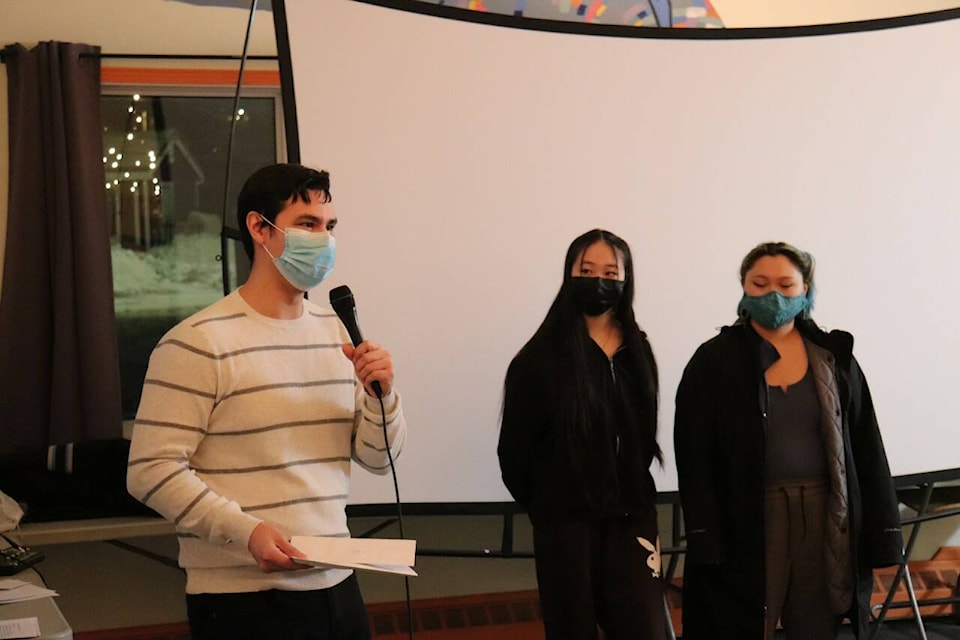On Feb. 1 four young Iqalummiut presented a review of Nunavut’s Interagency Information Sharing Protocol (IISP) at the Qajuqturvik Community Food Centre, making policy and practice recommendations on the protocol from a youth-led perspective.
IISP was developed in response to recommendations made in Nunavut’s Suicide Prevention Strategy Action Plan (Inuusivut Anninaqtuq) to help address the territory’s high rates of suicide by allowing departments to more easily share information when a subject may be suicidal. This in turn aids in having an appropriate intervention take place.
The youth took part in seven engagement sessions where they went over the protocol and made their recommendations based on those findings. They also looked at other models to see what works and what doesn’t, including Nunavut’s Inuusivut Anninaqtuq and PEI’s Bridge Model, which connects government and non-government agencies directly to individuals and families determined to be at very high risk of harm.
“In all those sessions they formed the recommendations that you see today,” said the project’s youth facilitator David Korgak.
One of these recommendations is a more proactive approach to maintaining and keeping mental health workers in Nunavut.
“Our solutions are to include available staff housing and assign those who are assigned to the IISP,” said Blake DeMaio, one of the youth involved in the project.
Another team member, Jasmine Evic, says people feel left in the dark when you pour your heart out to a therapist or counsellor who then goes back down south never to be seen again.
The group also recommends bringing in more Inuktitut speakers, given it is often the first language of many Nunavummiut in smaller communities outside of Iqaluit.
“Many children and youth do express their emotions in Inuktitut way better than they do in English,” DeMaio added, “I think that would help youth explain what’s going on in their life.”
Evic said she would like to see the territorial “government work together more, because there’s no communication between them.” She says it would be more beneficial for the youth, as the way things are currently going “just makes it harder for everyone to understand each other.”
The IISP was signed by the Department of Family Services, Health, Justice, Education, the RCMP and the Nunavut Housing Corporation. These departments were invited to the presentation, however only representatives from Family Services and the RCMP were present on Feb. 1.
Evic said she appreciated even those two parties being present as a good step to being heard, though the group would like to see a more active interest from the Government of Nunavut in what they have to say.
Korgak, a fellow at the Jane Glassco Northern Fellowship, helped initiate this presentation by getting the support of the Gordon Foundation, a charitable organization for empowering Canada’s North. He thanked the organization for providing “a lot of learning for young Northerners.”
A six-minute video presentation by DeMaio, Evic, Jennifer Williams and Rocco Canil was made to summarize these recommendations. The video can be found on YouTube titled Communication is Key: A Youth-led policy change project.
FACT FILE: Recommendations led by youth on the Interagency Information Sharing Protocol (IISP):
Policy recommendations:
- Make IISP training mandatory for all service providers in departments signed to the protocol. This includes making IISP training top priority to new employees in each signed department.
- Expand protocol to include youth centre or community wellness staff in hamlets/communities and include them in training.
- Create more levels of risk and timelines for follow-up associated with each level.
- Ensure there is a guide to outline roles/responsibilities and include a guide for frequency of interagency meetings.
Practice recommendations:
- Label Inuusivut staff to be essential workers permanently, due to the ongoing suicide crisis in the territory.
- Continually offer IISP training throughout the year in any form appropriate whether virtual or in-person.
- Staff IISP related positions indeterminately, with housing. Include a signing bonus for Inuit who are hired into those positions similar to the signing bonus of nurses.
- Require all relevant staff in the Inuusivut division are trained to deliver IISP training and that those staff track the number of participants in IISP training when it is delivered.
- Guarantee language is not a barrier to staff who may be working in their communities from participating in interagency meetings.
- Ensure the IISP is published publicly and ensure information can be accessed easily by anyone.
Source: Jasmine Evic, Rocco Canil, Blake DeMaio, Jennifer Williams
